Paleobotany/Palynology Home Page
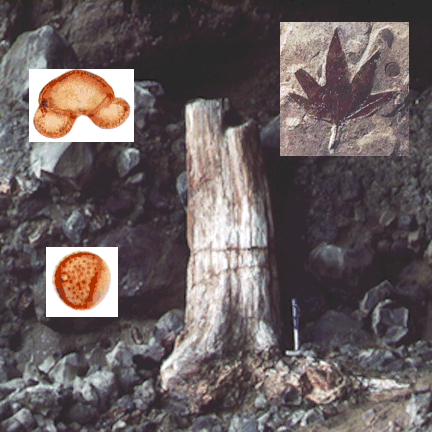
General Disclaimer
This Web project was developed as part of "Internet Resources" courses offered by the Biology and Geology departments of the California State University, Los Angeles in 1995 and 1996. It was submitted to the instructors for evaluation and then placed on-line by the Electronic Desktop Project (EDP). EDP does not update or maintain any of the material of this project, and does not vouch for validity or correctness. Furthermore, the student developing this project was instructed about the rules of copyrights. EDP can in no way be responsible for the inclusion of copyrighted material within this project.
Purpose
Welcome to the Paleobotany/Palynology Home Page. The
purpose of this home page is to provide paleobotanical &
palynological internet resources to scientists, students and other
interested individuals in these fields. It includes links to
paleobotanical/palynological fossil collections at universities and
museums, to paleobot/palynol scientific organizations, journals, info
on listservs related to these fields, as well as other resources
available thru ftp, gopher or other (such as software, newsletters,
publications, meetings of interest, bibliographic information,
catalogs and images).
This homepage does not pretend to be complete. It will be under
construction and continuously updated as new resources become
available.
- A very useful source for information is Bill Thoen's catalog of
internet earth sciences resources: "On-line Resources for Earth
Sciences (ORES).". You can access any of two versions:
- For more information on the hyper text markup language, check the
Beg
inner's Guide to HTML.
- To search the Internet with key words you can use:
Paleobotany
What is it?
Paleobotany is the study of fossil plants. During geologic history different plant parts have been preserved in a variety of depositional environments and thru many different processes. Leaves are the most common type of plant fossil and can be found as compressions, impressions, carbonizations. Stems, seeds and wood are usually petrified (permineralized), but can also form molds. Coal balls, coal, and peat contain abundant plant material in many cases with excellent preservation. Many plant parts may also be found preserved in amber, itself a fossilized plant resin. Algae and cyanobacteria are many times found forming deposits of calcium carbonate commonly called stromatolites and tufa.
Typical Fossils
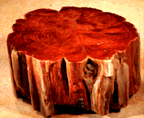 Petrified wood, Jurassic, Argentina
Petrified wood, Jurassic, Argentina
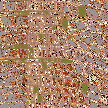 Microphotograph of Araucarioxylon (Araucaria) petrified wood showing the preserved cell structure. Paleobotanists make thin sections such as this and study the cells and vessels in transversal, radial, and tangential sections in order to identify the wood.
Microphotograph of Araucarioxylon (Araucaria) petrified wood showing the preserved cell structure. Paleobotanists make thin sections such as this and study the cells and vessels in transversal, radial, and tangential sections in order to identify the wood.
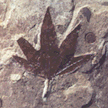 Fossil sycamore leaf, Eocene, Wyoming.
Fossil sycamore leaf, Eocene, Wyoming.
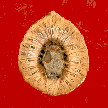 Silicified Araucaria cones from the Jurassic of Argentina have become a prized posession for fossil collectors.
Silicified Araucaria cones from the Jurassic of Argentina have become a prized posession for fossil collectors.
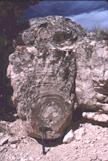 Logs stranded on the shore of Eocene Lake Gosiute in Wyoming were covered with algal mats which facilitated the precipitation of calcium carbonate in the form of stromatolitic tufa.
Logs stranded on the shore of Eocene Lake Gosiute in Wyoming were covered with algal mats which facilitated the precipitation of calcium carbonate in the form of stromatolitic tufa.
Paleobotanical Collections/Catalogs
Other Botanical/Herbarium Collections
Palynology
What is it?
Palynology is the science which studies plant microfossils (although it also includes modern forms). More specifically Paleopalynologystudies plant microfossils, especially those organic-walled which are composed of sporopollenin, such as acritarchs, dinoflagellates, and pollen and spores. These plant microfossils (terrestrial and marine) provide us with clues for interpreting geochronology, paleoclimate, paleoenvironments, paleoecology, paleoceanography, local tectonic histories, and the thermal maturity of sediments. Some of the most important clues help us correlate rocks in outcrop with those in the subsurface from both terrestrial and marine environments. In addition, palynology has been instrumental in archeological and anthropological studies around the world.
Typical Fossils
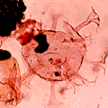 Dinoflagellate from the Mancos Shale, Cretaceous, CO.
Dinoflagellate from the Mancos Shale, Cretaceous, CO.
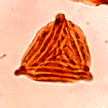 Fern spore from the Mancos Shale, Cretaceous, CO.
Fern spore from the Mancos Shale, Cretaceous, CO.
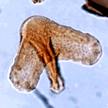 Mancicarpus pollen from the Mancos Shale, Cretaceous, CO.
Mancicarpus pollen from the Mancos Shale, Cretaceous, CO.
 Pleistocene mormon tea (above) and pine (below) pollen grains from the sediments in Kokoweef Cave, CA.
Pleistocene mormon tea (above) and pine (below) pollen grains from the sediments in Kokoweef Cave, CA.
 This Onagraceae family pollen grain is one of a variety of pollen grains from the Pleistocene of the Las Vegas Valley, Nevada.
This Onagraceae family pollen grain is one of a variety of pollen grains from the Pleistocene of the Las Vegas Valley, Nevada.
 Diatom, Kokoweef Cave, CA. Although not directly studied by palynologists, these plant microfossils provide important paleoenvironmental and paleoecological information.
Diatom, Kokoweef Cave, CA. Although not directly studied by palynologists, these plant microfossils provide important paleoenvironmental and paleoecological information.
Palynological Collections/Servers
The NOAA offers as part of their World Data Centre-A for
Paleoclimatology:
- Paleo/pollen
with pollen from the North American Pollen Database.
The Australian National University Bioinformatics Facility (ANUBF)
offers:
If you would like to know what the relationship between bees and pollen is check out the
Palynological Research at University of Calgary
Other Related Paleontologic Resources
Bibliography/Bibliographic Sources
There are hundreds of publications in both subjects at both the CSU or UC systems. Remember, you can access and search the CSULA Library (login as library) or UC Melvyl for books and CARL for articles.
As bibliographic databases become available (some already are in the works) we will certainly provide links to them.
The following has been added by the Electronic Desktop Project:
 Contact Us
Contact Us
Please take a few minutes to send us your comments and suggestions. We read every message and try to respond promptly to questions. Your feedback will help us improve our project.
If you are an educator who is using our NEXTSTEP or virtual applications in the classroom, we would especially like to hear from you. Let us know what you are doing and how it is working out. Continued support for this project will depend on its impact in science education.
If you are an educator who is interested in making use of our NEXTSTEP or virtual applications, please let us know how we can help.
Other Places To Go
 Return to the Electronic Desktop Project home page
Return to the Electronic Desktop Project home page
 Check out the WWW Virtual Application Catalog from the EDP
Check out the WWW Virtual Application Catalog from the EDP
 Check out the NEXTSTEP Application Catalog from the EDP
Check out the NEXTSTEP Application Catalog from the EDP
 Visit the home page for California State University, Los Angeles
Visit the home page for California State University, Los Angeles


 Petrified wood, Jurassic, Argentina
Petrified wood, Jurassic, Argentina Microphotograph of Araucarioxylon (Araucaria) petrified wood showing the preserved cell structure. Paleobotanists make thin sections such as this and study the cells and vessels in transversal, radial, and tangential sections in order to identify the wood.
Microphotograph of Araucarioxylon (Araucaria) petrified wood showing the preserved cell structure. Paleobotanists make thin sections such as this and study the cells and vessels in transversal, radial, and tangential sections in order to identify the wood. Fossil sycamore leaf, Eocene, Wyoming.
Fossil sycamore leaf, Eocene, Wyoming. Silicified Araucaria cones from the Jurassic of Argentina have become a prized posession for fossil collectors.
Silicified Araucaria cones from the Jurassic of Argentina have become a prized posession for fossil collectors. Logs stranded on the shore of Eocene Lake Gosiute in Wyoming were covered with algal mats which facilitated the precipitation of calcium carbonate in the form of stromatolitic tufa.
Logs stranded on the shore of Eocene Lake Gosiute in Wyoming were covered with algal mats which facilitated the precipitation of calcium carbonate in the form of stromatolitic tufa. Dinoflagellate from the Mancos Shale, Cretaceous, CO.
Dinoflagellate from the Mancos Shale, Cretaceous, CO. Fern spore from the Mancos Shale, Cretaceous, CO.
Fern spore from the Mancos Shale, Cretaceous, CO. Mancicarpus pollen from the Mancos Shale, Cretaceous, CO.
Mancicarpus pollen from the Mancos Shale, Cretaceous, CO. Pleistocene mormon tea (above) and pine (below) pollen grains from the sediments in Kokoweef Cave, CA.
Pleistocene mormon tea (above) and pine (below) pollen grains from the sediments in Kokoweef Cave, CA. This Onagraceae family pollen grain is one of a variety of pollen grains from the Pleistocene of the Las Vegas Valley, Nevada.
This Onagraceae family pollen grain is one of a variety of pollen grains from the Pleistocene of the Las Vegas Valley, Nevada. Diatom, Kokoweef Cave, CA. Although not directly studied by palynologists, these plant microfossils provide important paleoenvironmental and paleoecological information.
Diatom, Kokoweef Cave, CA. Although not directly studied by palynologists, these plant microfossils provide important paleoenvironmental and paleoecological information. Contact Us
Contact Us Return to the Electronic Desktop Project home page
Return to the Electronic Desktop Project home page![]() Check out the WWW Virtual Application Catalog from the EDP
Check out the WWW Virtual Application Catalog from the EDP Check out the NEXTSTEP Application Catalog from the EDP
Check out the NEXTSTEP Application Catalog from the EDP Visit the home page for California State University, Los Angeles
Visit the home page for California State University, Los Angeles